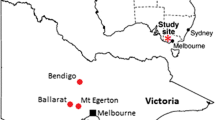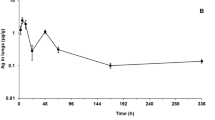Abstract
Arsenic is present in airborne particulate material released by coal-fired power plants and non-ferrous metal smelters. We have assessed whether the physico-chemical properties of arsenic in such particles play a role in its lung retention and uptake by the body. Female hamsters were given a single intratracheal instillation of fly ash or copper smelter dust suspensions (at doses of 50 or 100 μg As kg−1) or identical amounts of soluble tri- and pentavalent arsenic, in the presence or absence of an inert dust material (tungsten carbide). The concentration of the element was measured in a 24 hour urine sample collected on the 1st, 2nd and 6th day after treatment and arsenic remaining in lung tissue was determined at the end of the same time periods. Both lung retention and urinary As excretion indicate a prolonged contact of the lung tissue with particulate As in contrast to soluble As salts. In addition to the effect of solubility described here, more research is needed to determine the effect of particle size and lung loading on retention, as well as the potential differences in the lung inflammatory response using arsenic-rich particulates from various sources.
Similar content being viewed by others
References
Axelson, O., Dahlgren, E., Jansson, C.D. and Rehnlund, S.O. 1978. Arsenic exposure and mortality: a case-referent study from a Swedish copper smelter.British Journal of Industrial Medicine,35, 8–15.
Buchet, J.P., Lauwerys, R. and Roels, H. 1980. Comparison of several methods for the determination of arsenic compounds in water and in urine.International Archives of Occupational and Environmental Health,46, 11–29.
Brown, L.M., Pottern, L.M. and Blot, W.J. 1984. Lung cancer in relation to environmental pollutants emitted from industrial sources.Environmental Research,34, 250–261.
EPA 1984.Health assessment document for inorganic arsenic. Final report. Research Triangle Park, NC: US Environmental Protection Agency, Environmental Criteria and Assessment Office, 2-1-3-22, 9-1–9-4 EPA 600/8-83-021F.
Enterline, P.E., Henderson, V.L., and Marsh, G.M. 1987. Exposure to arsenic and respiratory cancer. A reanalysis.American Journal of Epidemiology,125, 929–938.
Hughes, J.P., Polissar, L. and Van Belle, G. 1988. Evaluation and synthesis of health effects studies of communities surrounding arsenic producing industries.International Journal of Epidemiology,17, 407–413.
IARC 1980.Some metals and metallic compounds. IARC monographs on the evaluation of the carcinogenic risk of chemicals to humans. Vol. 23 pp. 39–141. Lyon, France. International Agency for Research on Cancer.
Inamasu, T., Hisanaga, A., and Ishinishi, N. 1982. Comparison of arsenic trioxide and calcium arsenate retention in the rat lung after intratracheal instillation.Toxicology Letters,12, 1–5.
Järup, L., and Pershagen, G. 1991. Arsenic exposure, smoking, and lung cancer in smelter workers. A case-control study.American Journal of Epidemiology,134, 545–551.
Kuratsune, M., Tokudane, S., Shirakusa, T., Yoshida, M., Tokumitsu, Y., Hayano, T., and Seita, M. 1974. Occupational lung cancer among copper smelters.International Journal of Cancer,13, 52–558.
Lee, A.M. and Fraumeni, J.F. 1969. Arsenic and respiratory cancer in man: an occupational study.Journal of the National Cancer Institute,42, 1045–1052.
Mabuchi, K., Lilienfeld, A.M. and Snell, L.M. 1979. Lung cancer among pesticide workers exposed to inorganic arsenicals.Archives of Environmental Health,34, 312–320.
Marafante, E. and Vahter, M. 1987. Solubility, retention and metabolism of intratracheally and orally administered inorganic arsenic compounds in the hamster.Environmental Research,42, 72–82.
Morrow, P.E. 1992. Dust overloading of the lungs: update and appraisal.Toxicology and Applied Pharmacology,113, 1–12.
Muhle, H., Creutzenberg, O., Bellman, B., Heinrich, U. and Mermelstein, R. 1990. Dust overloading of lungs: investigations of various materials, species differences and irreversibility of effects.Journal of Aerosol Medicine,3, Suppl. 1, 111–128.
Ott, M.G., Holder, B.B. and Gordon, H.L. 1974. Respiratory cancer and occupational exposure to arsenicals.Archives of Environmental Health,29, 250–255.
Pershagen, G. 1985. Lung cancer mortality among men living near an arsenic-emitting smelter.American Journal of Epidemiology,122, 684–694.
Pinto, S.S., Henderson, V.L. and Enterline, P.E. 1978. Mortality experience of arsenic-exposed workers.Archives of Environmental Health,33, 325–331.
Tsuda, T., Nagira, T., Yamamoto, M. and Kume, Y. 1990. An epidemiological study on cancer in certified arsenic poisoning patients in Toroku.Industrial Health,28, 53–62.
Author information
Authors and Affiliations
Rights and permissions
About this article
Cite this article
Buchet, J.P., Lauwerys, R.R. & Yager, J.W. Lung retention and bioavailability of arsenic after single intratracheal administration of sodium arsenite, sodium arsenate, fly ash and copper smelter dust in the hamster. Environ Geochem Health 17, 182–188 (1995). https://doi.org/10.1007/BF00661330
Received:
Accepted:
Issue Date:
DOI: https://doi.org/10.1007/BF00661330




